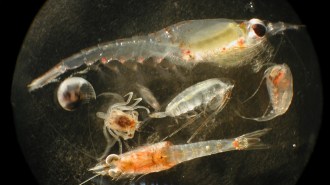The clearing of jungle to create cropland is a major and previously underappreciated force behind deforestation of the Amazon region of Brazil, according to an analysis of satellite images. The practice accounts for about one-sixth of recent forest loss in the region.
Most conservationists had assumed that new crop fields in the Amazon region usually spring up on former pasturelands.
The new findings suggest that the international demand for soybeans and other Brazilian crops is driving industrialized farming operations to clear-cut and cultivate large tracts of virgin forest.
A previous study estimated that two-fifths of the country’s existing jungle may disappear by 2050 (SN: 4/8/06, p. 221: Available to subscribers at Two-fifths of Amazonian forest is at risk).
While forest clearance for new farmland appears to be on the rise, the top driver of Amazon deforestation continues to be conversion of forest to cattle pasture. New grazing lands accounted for slightly more than half of lost forest area during the study, which lasted from 2001 to 2004.
“There’s been debate about whether the increase in cropland in Brazil has occurred on already-cleared lands, or whether [expansion of] cropland is leading to new deforestation,” says Ruth S. DeFries of the University of Maryland at College Park.
She and her colleagues analyzed 4 years of satellite images of the Brazilian state of Mato Grosso, where most of Brazil’s export crops grow and where deforestation is occurring most rapidly.
The team studied seasonal variations in the greenness of plots of land and, by visiting certain sites, linked the color patterns to forms of land use. Cropland is intensely green during the summer growing season and brown during the winter, while forest is green throughout the year, DeFries says. Pastures tend to show limited seasonal changes and are, on average, less green than forests.
On the basis of the team’s readings, cropland expansion accounted for more than 5,400 square kilometers of lost forest during the study. The extent of loss ranged from 785 to 2,150 km2 per year. Those annual losses correlated with each year’s average soybean price, and both variables peaked in 2003. The market value of soybeans recently dipped, and deforestation declined, but a recovery could accelerate deforestation, the researchers suggest in an upcoming Proceedings of the National Academy of Sciences.
On average, says DeFries, “the size of the clearings used for cropland is about twice as large as the size of the clearings used for pasture.” Large clearings tend to fragment forest into small chunks that could isolate vulnerable species, she says.
Brazil’s government has been monitoring the rate of Amazon deforestation since 1988, but it hasn’t had an efficient method for gauging the subsequent use of cleared forest areas, says Carlos M. Souza Jr., a geographer at the Amazon Institute for People and the Environment in Belém, Brazil. The new study demonstrates such a method, he says, which “allows us to track land use after deforestation.”







